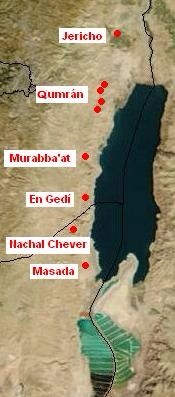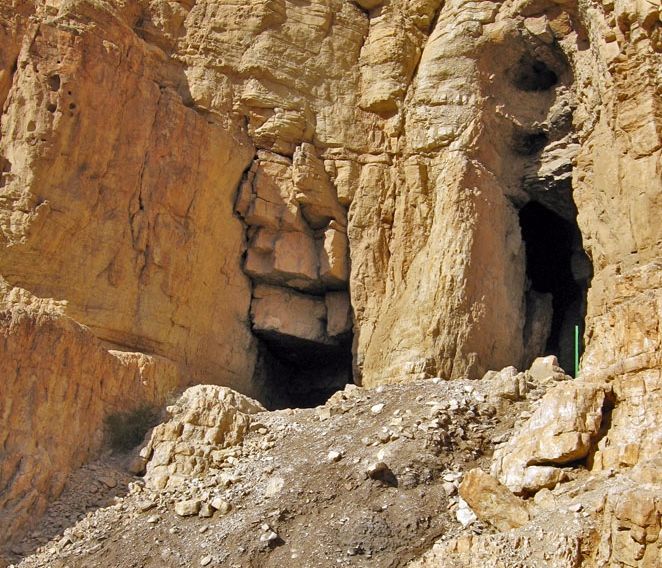 Edit article
Edit articleSeries
Part 2
Judean Desert Texts Outside Qumran

Signpost to Muraba’at Caves, where some proto-Masoretic scrolls were found תמר הירדני Wikipedia
Before the mid-20th century, many scholars divided the texts of the Hebrew Bible into three text types: the Masoretic Text (MT), the Samaritan Pentateuch (SP), and the LXX. Between 1947 and and 1956, however, many biblical scrolls dating back to the Second Temple Period were uncovered in the caves of Qumran that did not fit into this neat three-version pattern. These scrolls, belonging to the sect of Jews who lived in the area, display broad textual diversity.

In contrast, twenty-five texts were found in the Judean Desert at sites other than Qumran, and these display almost complete identity (roughly 98% agreement) in consonants with the medieval Masoretic text as reflected in the Leningrad Codex, the earliest complete version of MT.[1] Thus, the consonantal text of MT was in existence more than a thousand years before the creation of MT. Scholars usually designate this consonantal base of the Masoretic Text as proto-Masoretic although sometimes also, anachronistically, as the Masoretic Text.[2]
The non-Qumran Judean Desert scrolls were found at both the earlier site of Masada (texts written between 50 BCE and 30 CE)[3] and the later sites of Wadi Murabba‘at, Wadi Sdeir, Naḥal Ḥever, Naḥal ‘Arugot, and Naḥal Se’elim, dating to the period of the Bar Kochba revolt in 132–135 CE. The latter were copied between 20 and 115 CE. 4QGenb needs to be added to this group,[4] as well as the recently opened En-Gedi scroll agreeing with the consonantal text of codex L in all of its details.
No complete proto-MT scrolls have been found; just partial scrolls and fragments. Thus, only a very small percentage of the proto-MT biblical text has survived, possibly five percent. Nevertheless, since the surviving texts are virtually identical with the medieval MT, we believe that the non-extant portions of proto-MT would have been identical with the consonants of the medieval text.

Examples of Surviving Proto-MT Texts
That the early scrolls and the medieval texts are virtually identical can be seen best in an examination of several well-preserved texts such as:[5]

Masada Psalms scroll copy a (MasPsa) – dating to the end of the 1stcentury BCE, and containing one complete and two fragmentary columns.
Masada Leviticus scroll copy b (MasLevb) – dating to 30 BCE–30 CE, and containing five fragmentary columns.
Psalms scroll from cave 5/6 in Naḥal Ḥever (5/6ḤevPs) – dating to 50–68 CE, and containing twelve fragmentary columns.
Murabba‛at scroll of the Minor Prophets (MurXII) – dating to c. 115 CE and containing major parts of these books in 21 columns
En-Gedi scroll of Leviticus 1-2 – ascribed to the 1st–2nd century CE as shown by Segal et al.[6]
This last text was deciphered and published only in 2016, and although its evidence is fragmentary, pertaining to chapters 1–2 only, it was the first time an ancient text agreed entirely with the consonantal medieval text.
The other Judean texts of the same type differ in a few details but never more than the medieval texts differ among each other. If the degree of divergence between the proto-MT scrolls and the medieval text would be measured statistically, it probably would be in the region of up to 2% of the text words.
The categories of differences pertain to details of spelling, small linguistic differences, and minute content differences. Thus, the relationship between MT and the ancient Judean Desert texts is one of almost complete identity showing that the consonantal framework of MT changed very little over the course of one thousand years—the period between the scrolls and the earliest medieval codices.
TheTorah.com is a 501(c)(3) nonprofit organization.
We rely on the support of readers like you. Please support us.
Published
December 8, 2017
|
Last Updated
March 24, 2025
Previous in the Series
Next in the Series
Before you continue...
Thank you to all our readers who offered their year-end support.
Please help TheTorah.com get off to a strong start in 2025.
Footnotes


Prof. Emanuel Tov is J. L. Magnes Professor of Bible (emeritus) in the Dept. of Bible at the Hebrew University, where he received his Ph.D. in Biblical Studies. He was the editor of 33 volumes of Discoveries in the Judean Desert. Among his many publications are, Scribal Practices and Approaches Reflected in the Texts Found in the Judean Desert, Textual Criticism of the Bible: An Introduction, The Biblical Encyclopaedia Library 31 and The Text-Critical Use of the Septuagint in Biblical Research.
Essays on Related Topics:









